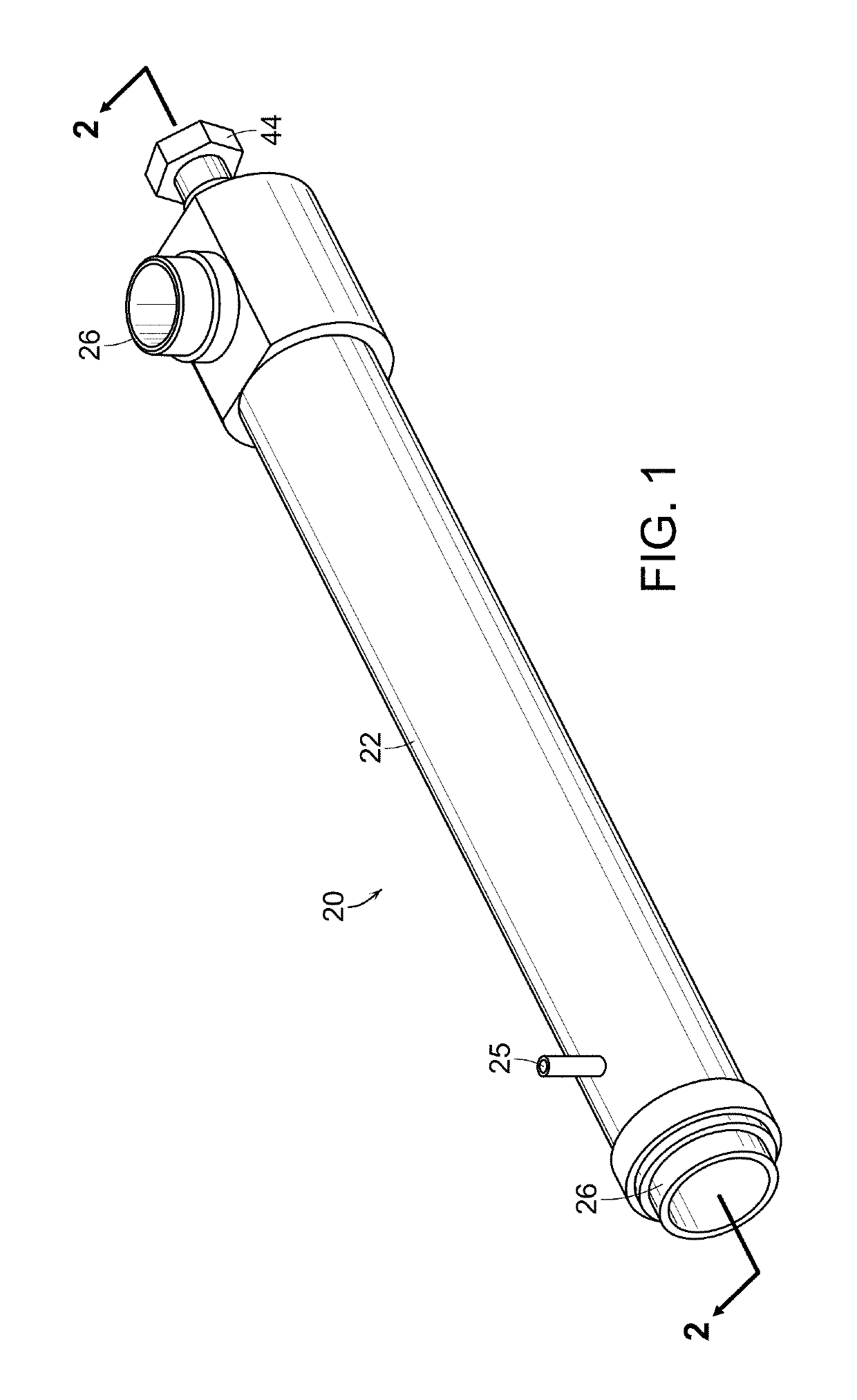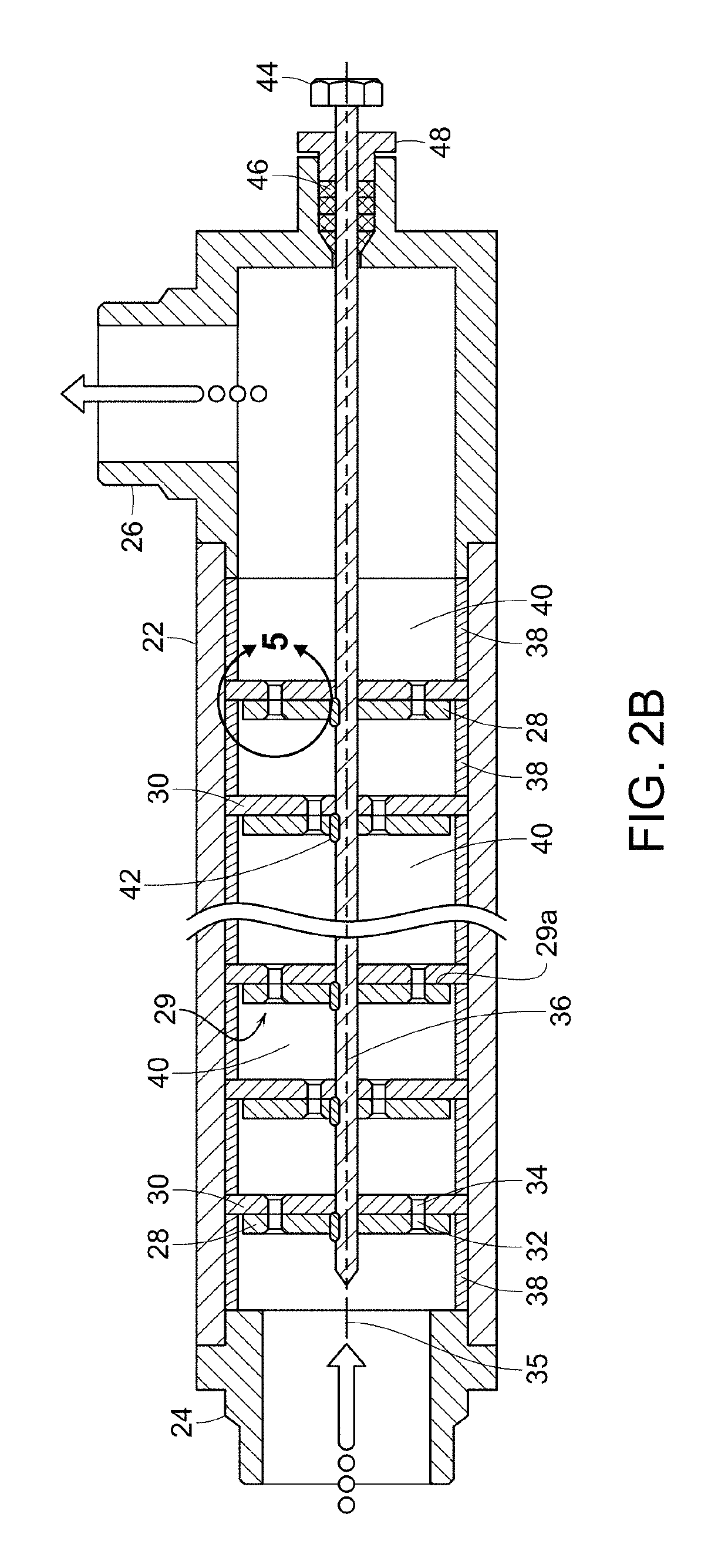Variable flow-through cavitation device
a cavitation device and variable technology, applied in the field of flow-through, high-shear mixers and cavitation apparati, can solve the problems of insufficient efficiency of sonic or ultrasonic processing performed in a static vessel, localized increase in pressure and temperature, formation of cavitation bubbles, etc., to achieve high treatment efficiency, rapid mass transfer, and superior capacity
- Summary
- Abstract
- Description
- Claims
- Application Information
AI Technical Summary
Benefits of technology
Problems solved by technology
Method used
Image
Examples
example 1a
[0080]Values for cavitation number, calculated with the specialized software ANSYS for the cavitation device 20 (length 70 cm, diameter 6 cm, 10 multi-jet nozzles) which is similar to the apparatus shown in FIG. 2B. The calculation was performed for the initial position of disks 28 and 30 at fully aligned channels 32 and 34 (FIG. 6A). The channels have the Venturi tube profile in a longitudinal section (FIG. 5D). The device 20 was operated at a flow rate of 50 gpm and an inlet pressure of 272 psi. The calculation results at 25 C are shown in FIG. 9A in the form of water flow lines. Cavitation numbers were calculated for each working chamber 40 following a variable multi-jet nozzle 29, and had values of 0.752, 0.645, 0.818, 0.611, 0.583, 0.442, 0.353, 0.254, 0.154, and 0.127, respectively, assuming flow moves from left to right.
example 1b
[0081]Values for cavitation number, calculated with the specialized software ANSYS for the cavitation device 20 (length 70 cm, diameter 6 cm, 10 multi-jet nozzles) which is similar to the apparatus shown in FIG. 2B. The calculation was performed for the position of disks 28 rotated by 5 degrees relative to disk 30 from the fully aligned position. Channels 32 and 34 are partially offset from each other, as in the example shown in FIG. 6B. The channels have the Venturi tube profile in the longitudinal section (FIG. 5D). The device 20 was operated at a flow rate of 40 gpm and an inlet pressure of 279 psi. The calculation results are shown in FIG. 9B in the form of water flow lines at 25 C. Cavitation numbers were calculated for each working chamber 40 following a variable multi-jet nozzle 29, and had values of 0.798, 0.700, 0.872, 0.656, 0.612, 0.578, 0.406, 0.312, 0.168, and 0.117, respectively, assuming flow moves from left to right.
example 1c
[0082]Values for cavitation number, calculated with the specialized software ANSYS for the cavitation device 20 (length 70 cm, diameter 6 cm, 10 multi-jet nozzles) which is similar to the apparatus shown in FIG. 2B. The calculation was performed for the position of disks 28 rotated by 18 degrees relative to disk 30 from the fully aligned position. Channels 32 and 34 are partially offset from each other, as similar to the example shown in FIG. 6B. The channels have the Venturi tube profile in longitudinal section (FIG. 5D). The device 20 was operated at a flow rate of 20 gpm and an inlet pressure of 275 psi. The calculation results are shown in FIG. 9C in the form of water flow lines at 25 C. Cavitation numbers were calculated for each working chamber 40 following a variable multi-jet nozzle 29, and had values of 0.801, 0.715, 0.813, 0.701, 0.577, 0.431, 0.328, 0.205, 0.125, and 0.010, respectively, assuming flow moves from left to right.
[0083]As seen from the calculation results sho...
PUM
| Property | Measurement | Unit |
|---|---|---|
| particle sizes | aaaaa | aaaaa |
| temperature | aaaaa | aaaaa |
| pressure | aaaaa | aaaaa |
Abstract
Description
Claims
Application Information
 Login to View More
Login to View More - R&D
- Intellectual Property
- Life Sciences
- Materials
- Tech Scout
- Unparalleled Data Quality
- Higher Quality Content
- 60% Fewer Hallucinations
Browse by: Latest US Patents, China's latest patents, Technical Efficacy Thesaurus, Application Domain, Technology Topic, Popular Technical Reports.
© 2025 PatSnap. All rights reserved.Legal|Privacy policy|Modern Slavery Act Transparency Statement|Sitemap|About US| Contact US: help@patsnap.com



